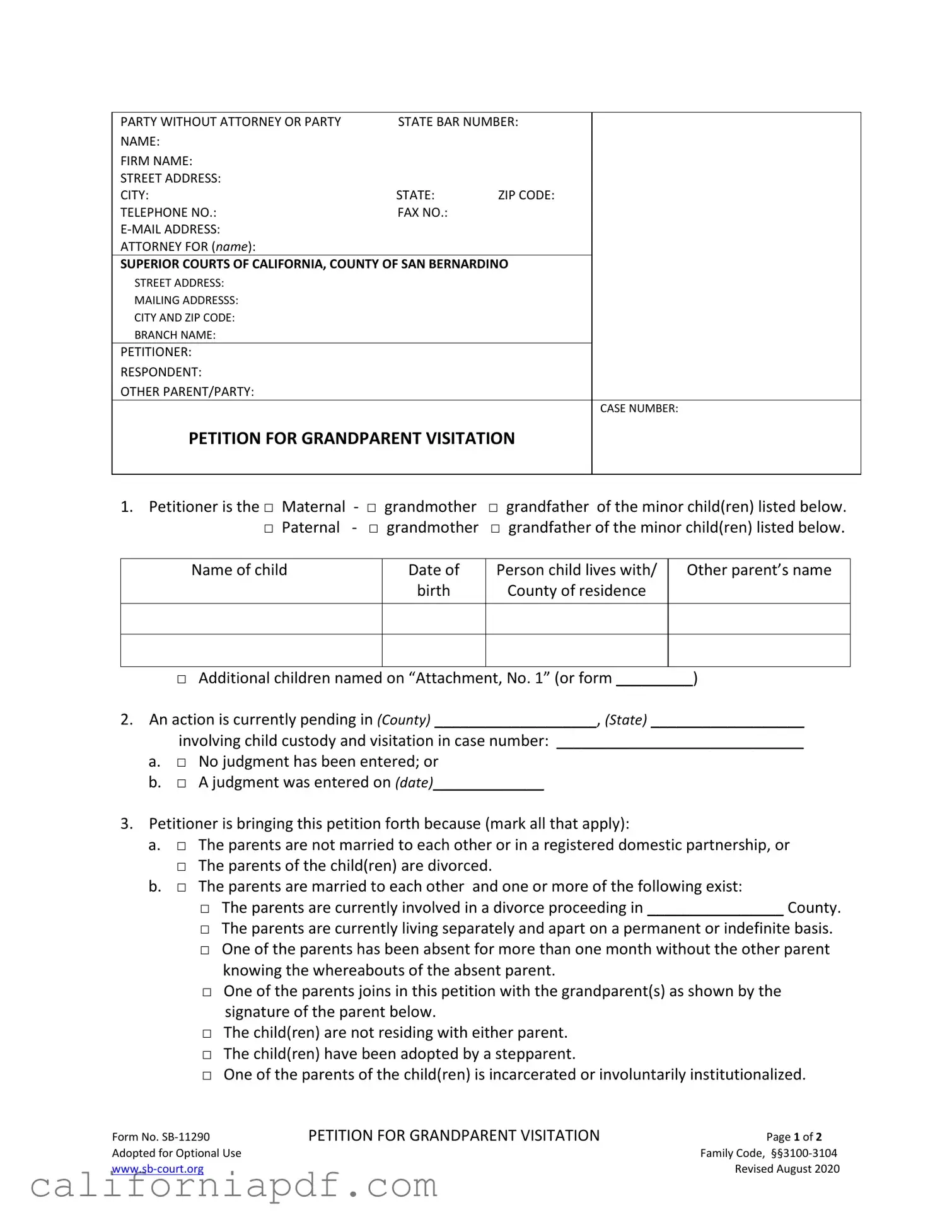The California SB-11290 form, a petition for grandparent visitation, shares similarities with the Petition for Custody and Support of Minor Children. Both documents require detailed information about the child or children involved, including their names, dates of birth, and current living arrangements. The goal of both forms is to establish a legal framework around the child's care and relationships, focusing on the best interests of the child while navigating through sensitive family dynamics. The key distinction lies in the relationship of the petitioner to the child, with one emphasizing parental rights and the other granting legal recognition to the important role grandparents can play in a child's life.
The Request for Order (FL-300) form is another document with notable similarities to the SB-11290 form. It's used when a party seeks court orders related to child custody, visitation, or support in a divorce or separation case. Both the SB-11290 and the FL-300 involve initiating action in family court to modify or establish child-related arrangements. However, while the FL-300 can be broad in its application to various family law matters, the SB-11290 specifically targets the unique scenario of grandparent visitation rights.
Declaration Under Uniform Child Custody Jurisdiction and Enforcement Act (UCCJEA) FL-105 form shares commonalities with the SB-11290 by addressing legal matters concerning children's living situations. Both are used in cases where the court's jurisdiction over a child custody matter needs to be established, ensuring that orders are made considering the child's best interest. The main difference lies in their focus; the UCCJEA declaration is broader, dealing with jurisdiction across state lines, whereas SB-11290 is specifically focused on grandparent visitation within the state's legal framework.
The Petition to Establish Parental Relationship (form FL-200) is related to the SB-11290 form in that it seeks to legally define a relationship with a child, though from a different perspective. The FL-200 is used when unmarried parents want to establish legal paternity, custody, visitation, and support matters. Like the SB-11290, this form recognizes the importance of formalizing relationships with children in the eyes of the law but focuses on parents rather than grandparents.
The Child Custody and Visitation Application Attachment (FL-311) also parallels the SB-11290 form through its focus on detailing custody and visitation arrangements. Both documents necessitate outlining a proposed schedule for how and when the child will spend time with the non-custodial family members. The primary distinction between them is that the FL-311 is more versatile, applicable to any custodial case, whereas the SB-11290 is tailor-made for grandparents seeking visitation rights.
Similarly, the Declaration of Disclosure (FL-140) form, while primarily used in divorce proceedings to disclose financial information, has an indirect linkage to the SB-11290 in its role in family law cases. Both forms are integral parts of cases affecting a child's welfare and family structure. While the Declaration of Disclosure focuses on finances to ensure fair division of assets and responsibilities, the SB-11290 focuses on maintaining family bonds and ensuring the child's right to relationships with their grandparents.
Another related document, the Application for Order and Supporting Declaration (FL-310), is used to request court orders in a family law case and requires a detailed declaration supporting the request, similar to how the SB-11290 form mandates an explanation for the petition for grandparent visitation. Both forms enable the court to make informed decisions based on the best interests of the child or children involved, though they serve different specific purposes within family law.
The Income and Expense Declaration (FL-150) is crucial in family law for providing a transparent view of an individual's financial status, affecting decisions on child support and spousal support orders. While it does not directly relate to grandparent visitation rights like the SB-11290, it plays a significant role in cases where child welfare, including financial support and stability, is a concern.
Lastly, the Stipulation and Order (various forms, depending on the situation) is a form that allows parties to reach an agreement on family law matters and have that agreement become a court order. Similar to the SB-11290, it can involve agreements related to children, such as custody and visitation schedules. While the SB-11290 is a petition that may lead to a court-ordered visitation schedule for grandparents, the Stipulation and Order forms encapsulate agreements across a wider range of family law issues, also secured by the court's authority.
By examining the SB-11290 form in the context of these nine other legal documents, it's clear that while each form has its unique purpose and application, they collectively serve to address the comprehensive needs and rights of children and families within California's legal system.

